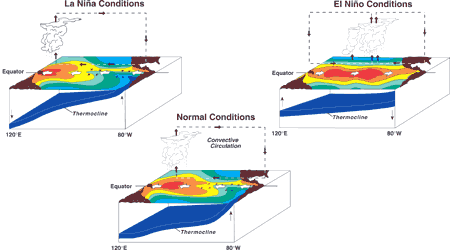El Nino & La Nina
The word "El Nino," which means "the little boy" (i.e., God's Child or Jesus Christ) in Spanish, originally indicated a local phenomenon in which a warm ocean current from the south intrudes into the cold sea water in the waters off Peru. At present, El Nino indicates a more global phenomenon that includes other atmosphere-ocean variations over the whole tropical Pacific. When the trade winds (easterly winds) along the equator are weakened, cold-water upwelling on the coast of Peru is weakened. The sea surface temperatures over the central and eastern equatorial Pacific, which are usually colder than the western tropical Pacific, are then increased. As a consequence of these events, locations of strong atmospheric convections are changed, significantly influencing the atmospheric general circulation fields and rainfall amounts. El Nino thus tends to cause various abnormal weather conditions throughout the world.
La Nina, which means "the little girl" in Spanish, is opposite to El Nino. When the easterly winds along the equator are strengthened, the sea surface temperatures over the central and eastern equatorial Pacific become lower than in normal years. These changes also affect the atmospheric general circulation fields. La Nina is also a trigger of abnormal weather conditions, but to a lesser extent than El Nino.
La Nina, which means "the little girl" in Spanish, is opposite to El Nino. When the easterly winds along the equator are strengthened, the sea surface temperatures over the central and eastern equatorial Pacific become lower than in normal years. These changes also affect the atmospheric general circulation fields. La Nina is also a trigger of abnormal weather conditions, but to a lesser extent than El Nino.
| Schematic Model of Atmosphere-ocean Interaction for El Nino, La Nina and normal conditions. |
|
 |
|
Images show distributions of sea surface temperature, depth of thermocline, anomaly of trade winds, convective activities and atmospheric circulations over the equatorial Pacific between Australia and South America. Center: Normal conditions. Because of upwelling along the South American coast caused by the trade winds, the sea-surface temperature of the eastern part is lower than that of the western part. Left: La Nina conditions. The eastern Pacific thermocline becomes shallower than normal, and the sea surface temperature becomes lower. In contrast, the western Pacific thermocline becomes deeper, and center positions of warm pools, the highest temperature regions in the western Pacific, and convective activities move westward. Right: El Nino conditions. Since the trade winds over the equator are weakened, upwelling along the coast of South America also becomes weaker. Warmer sea surface regions extend eastward over the equator, and the center of convective activities also shifts to central Pacific. Images provided by Dr. Michael J. MacPhaden , the Tropical Atmosphere-Ocean (TAO) Project Office, Pacific Marine Environmental Laboratory (PMEL), National Oceanic and Atmospheric Administration (NOAA). |